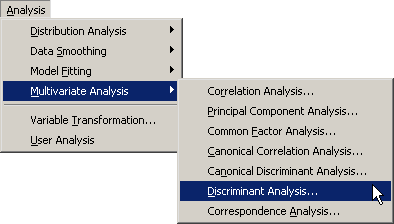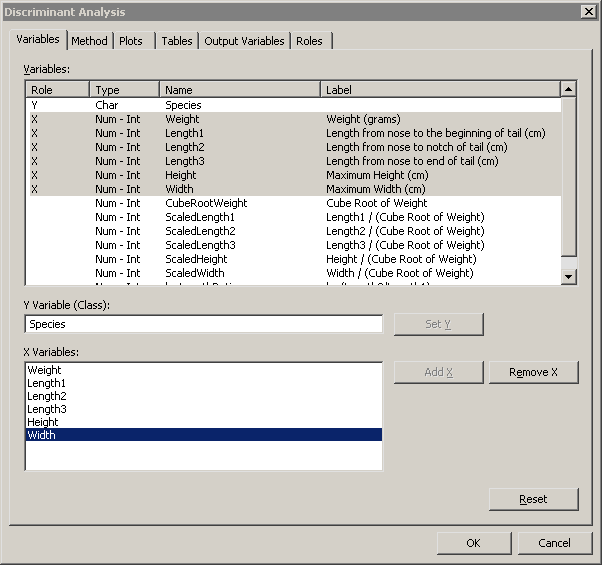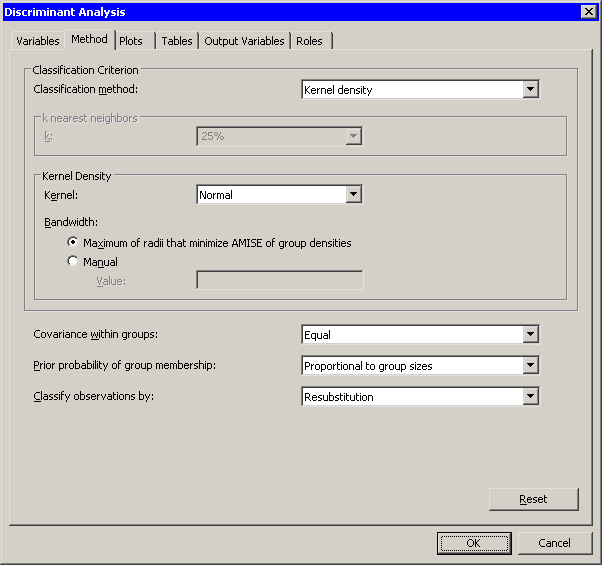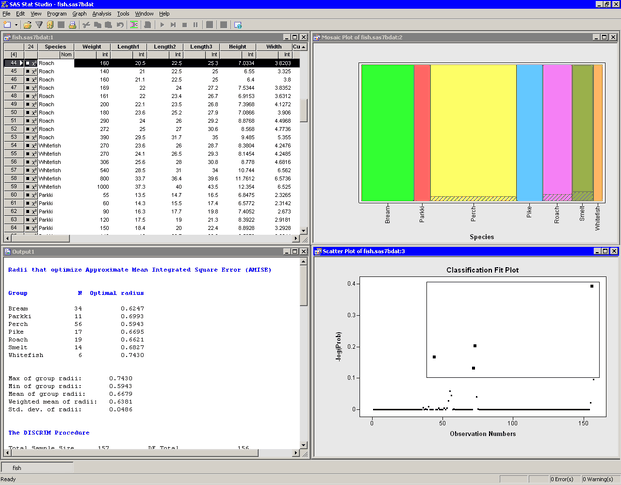Multivariate Analysis: Discriminant Analysis
In this example, you examine measurements of 159 fish caught in Finland’s Lake Laengelmavesi. The fish are one of seven species: bream, parkki, perch, pike, roach, smelt, and whitefish. Associated with each fish are physical measurements of weight, length, height, and width.
To construct a discriminant function that classifies species based on physical measurements:
-
Select → → from the main menu, as shown in Figure 30.1.
The Discriminant Analysis dialog box appears. (See Figure 30.2.) You can select variables for the analysis by using the Variables tab.
-
Select
Speciesand click . -
Select
Weight. While holding down the CTRL key, selectLength1,Length2,Length3,Height, andWidth. Click .Note: Alternately, you can select the variables by using contiguous selection: click the first variable (
Weight), hold down the SHIFT key, and click the last variable (Width). All variables between the first and last item are selected and can be added by clicking . -
Click the Method tab.
The Method tab becomes active. (See Figure 30.3.) You can use the Method tab to set options in the analysis.
-
Select for .
The options that are associated with the kernel density classification method become active.
-
Select for .
The number of fish in the lake probably varies by species. That is, there is no reason to suspect that the number of whitefish in the lake is the same as the number of perch or bream. In the absence of prior knowledge about the distribution of fish species, you can assume that the number of fish of each species in the lake is proportional to the number in the sample.
-
Select for .
-
Click the Plots tab.
The Plots tab becomes active. (See Figure 30.4.)
-
Select .
-
Click .
The analysis calls the DISCRIM procedure. The procedure uses the options specified in the dialog box. The procedure displays tables in the output document, as shown in Figure 30.5. Two plots are also created.
Move the classification fit plot so that the workspace is arranged as in Figure 30.5.
The classification fit plot indicates how well each observation is classified by the discriminant function. For each observation,
PROC DISCRIM computes posterior probabilities for membership in each group. Let ![]() be the maximum posterior probability for the ith observation. The classification fit plot is a plot of
be the maximum posterior probability for the ith observation. The classification fit plot is a plot of ![]() versus i. In Figure 30.5, the selected observations are those with
versus i. In Figure 30.5, the selected observations are those with ![]() . Equivalently, the maximum posterior probability for membership for the selected observations is less than
. Equivalently, the maximum posterior probability for membership for the selected observations is less than ![]() . The selected fish are those with relatively large probabilities of misclassification. Conversely, selecting the bream, parkki,
and pike species in the spine plot (the upper right plot in Figure 30.5) shows that the classification criterion discriminates between these species quite well. A spine plot is a one-dimensional mosaic plot in which the width of a bar represent the number of observations in a category.
. The selected fish are those with relatively large probabilities of misclassification. Conversely, selecting the bream, parkki,
and pike species in the spine plot (the upper right plot in Figure 30.5) shows that the classification criterion discriminates between these species quite well. A spine plot is a one-dimensional mosaic plot in which the width of a bar represent the number of observations in a category.
Note: If there are k groups, then the maximum posterior probability of membership is at least ![]() , so the vertical axis of the classification fit plot is bounded above by
, so the vertical axis of the classification fit plot is bounded above by ![]() .
.
The output window contains many tables of statistics. The first table in Figure 30.5 is produced by SAS/IML Studio. It is associated with a heuristic method of choosing the bandwidth for the kernel density classification method. This table is described in the section The Method Tab.
Figure 30.6 displays a table that summarizes how many fish are classified (or misclassified) into each species. If the discriminant function correctly classifies most observations, then the elements on the table’s main diagonal are large compared to the off-diagonal elements. For this example, the nonparametric discriminant function correctly classified all fish into the species to which they belong.
Note: The classification in this example was performed using resubstitution. This estimate of the error rate is optimistically biased. You can obtain a less biased estimate by using cross validation. You can select cross validation for the option on the Method tab.
In summary, the nonparametric discriminant function in this example does an excellent job of discriminating among these species of fish.





